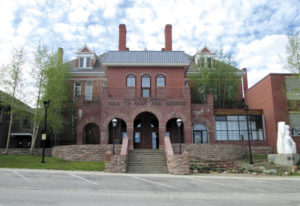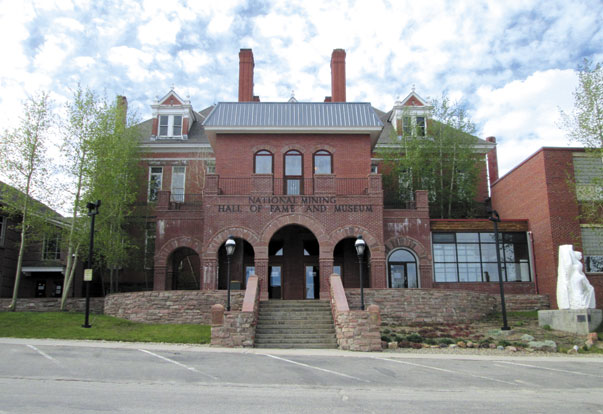By Stephen L. Whittington
The National Mining Hall of Fame and Museum (NMHFM) was founded in Leadville in 1987 and occupies the former high school building, built in 1899. In 1988, the U.S. Congress granted the NMHFM a Federal charter, which was signed by President Ronald Reagan. The NMHFM is an independent non-profit organization and does not receive financial support from the Federal government. Its mission is to “tell the story of mining, its people and its importance to the American public.” The NMHFM is dedicated to presenting an accurate picture of the mining industry, its critical impact on everyday life and its place in the Nation’s future.
 Each year, a class of four or five individuals who have had a significant impact on American mining and mineral extraction is inducted into the Hall of Fame. The annual Induction Banquet rotates among various cities across the country. Currently, 240 inductees have their photos and biographies displayed in the Hall of Fame and on the NMHFM’s website.
Each year, a class of four or five individuals who have had a significant impact on American mining and mineral extraction is inducted into the Hall of Fame. The annual Induction Banquet rotates among various cities across the country. Currently, 240 inductees have their photos and biographies displayed in the Hall of Fame and on the NMHFM’s website.
The NMHFM continuously strives to increase interest in and awareness of the importance of mining through dynamic and educational exhibits and programs. The 25,000 square feet of enlightening and interactive exhibits about past, current and future mining practices include “The World of Molybdenum,” “Buried Sunlight: Coal Mining in America,” and “Expanding Boundaries: Harrison Schmitt and the New Mining Frontier,” as well as three walk-through mine replicas. Exhibits incorporate many videos and hands-on activities.
[InContentAdTwo]
The Matchless Mine, listed on the National Register of Historic Places in 2010 and located about 1.25 miles east of the museum building in the Leadville Mining District, is integral to fulfilling the mission of the NMHFM. The Matchless Mine played an important role in Colorado history as a major source of the fortune of H.A.W. Tabor and his second wife, “Baby Doe,” during the 1880s. Tabor eventually became Lt. Governor and Senator and used his fortune to construct important buildings in Leadville and Denver, including Leadville’s Tabor Opera House. After the fortune was lost and Tabor passed away, Baby Doe lived in a shack at the mine until she died there 35 years later. Knowledgeable and engaging guides lead visitors on surface tours of the claim every day during the summer months.
The National Mining Hall of Fame and Museum is an important part of the cultural tourism scene in Leadville and Lake County. More than 20,000 people from every state and many other countries visit the NMHFM each year. The museum is open 9 a.m. -5 p.m. Tuesday-Sunday from November through April and daily from May through October.
Visit www.mininghalloffame.org or call (719) 486-1229 for more information.
Stephen L. Whittington is the executive director of the National Mining Hall of Fame and Museum.


